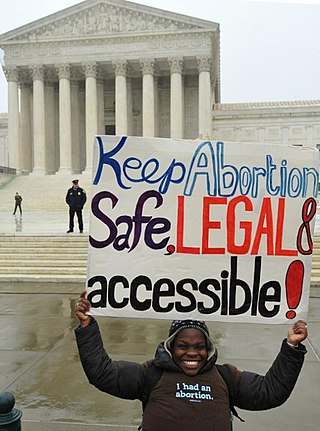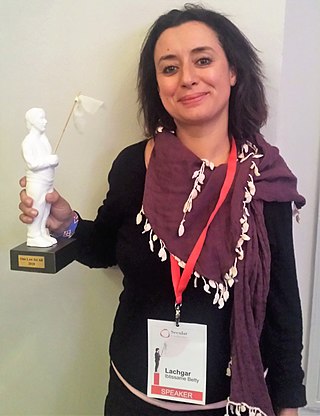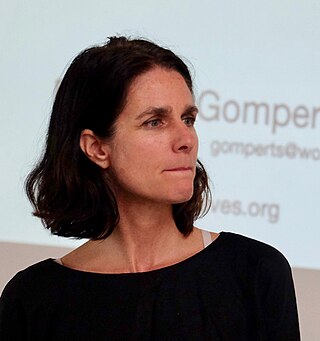
A self-induced abortion is an abortion performed by the pregnant woman herself, or with the help of other, non-medical assistance. Although the term includes abortions induced outside of a clinical setting with legal, sometimes over-the-counter medication, it also refers to efforts to terminate a pregnancy through alternative, potentially more dangerous methods. Such practices may present a threat to the health of women.
This is a timeline of reproductive rights legislation, a chronological list of laws and legal decisions affecting human reproductive rights. Reproductive rights are a sub-set of human rights pertaining to issues of reproduction and reproductive health. These rights may include some or all of the following: the right to legal or safe abortion, the right to birth control, the right to access quality reproductive healthcare, and the right to education and access in order to make reproductive choices free from coercion, discrimination, and violence. Reproductive rights may also include the right to receive education about contraception and sexually transmitted infections, and freedom from coerced sterilization, abortion, and contraception, and protection from practices such as female genital mutilation (FGM).

Reproductive justice is a critical feminist framework that was invented as a response to United States reproductive politics. The three core values of reproductive justice are the right to have a child, the right to not have a child, and the right to parent a child or children in safe and healthy environments. The framework moves women's reproductive rights past a legal and political debate to incorporate the economic, social, and health factors that impact women's reproductive choices and decision-making ability.

Women on Web (WoW) is a Canadian non-profit organization that aims to increase access to safe abortion known for its online abortion service accessible in multiple countries. The organization was founded by Dr. Rebecca Gomperts, a Dutch physician, in 2005.

Birth control, also known as contraception, anticonception, and fertility control, is the use of methods or devices to prevent unintended pregnancy. Birth control has been used since ancient times, but effective and safe methods of birth control only became available in the 20th century. Planning, making available, and using human birth control is called family planning. Some cultures limit or discourage access to birth control because they consider it to be morally, religiously, or politically undesirable.
Abortion in Venezuela is currently illegal except in some specific cases outlined in the Venezuelan Constitution, and the country has one of Latin America's most restrictive laws.

The birth control movement in the United States was a social reform campaign beginning in 1914 that aimed to increase the availability of contraception in the U.S. through education and legalization. The movement began in 1914 when a group of political radicals in New York City, led by Emma Goldman, Mary Dennett, and Margaret Sanger, became concerned about the hardships that childbirth and self-induced abortions brought to low-income women. Since contraception was considered to be obscene at the time, the activists targeted the Comstock laws, which prohibited distribution of any "obscene, lewd, and/or lascivious" materials through the mail. Hoping to provoke a favorable legal decision, Sanger deliberately broke the law by distributing The Woman Rebel, a newsletter containing a discussion of contraception. In 1916, Sanger opened the first birth control clinic in the United States, but the clinic was immediately shut down by police, and Sanger was sentenced to 30 days in jail.

Birth control in the United States is available in many forms. Some of the forms available at drugstores and some retail stores are male condoms, female condoms, sponges, spermicides, and over-the-counter emergency contraception. Forms available at pharmacies with a doctor's prescription or at doctor's offices are oral contraceptive pills, patches, vaginal rings, diaphragms, shots/injections, cervical caps, implantable rods, and intrauterine devices (IUDs). Sterilization procedures, including tubal ligations and vasectomies, are also performed.
The Irish Family Planning Association (IFPA) is an Irish charity working to enable people to make informed choices about sexuality and reproduction. The organisation promotes the right of all people to sexual and reproductive health information as well as dedicated, confidential and affordable healthcare services.
Reproductive coercion is a collection of behaviors that interfere with decision-making related to reproductive health. These behaviors are meant to maintain power and control related to reproductive health by a current, former, or hopeful intimate or romantic partner, but they can also be perpetrated by parents or in-laws. Coercive behaviors infringe on individuals' reproductive rights and reduce their reproductive autonomy.

Vessel is a 2014 multi-national documentary film written and directed by Diana Whitten as her debut film, focusing on the work of Women on Waves, a Dutch pro-choice organization founded by the Dutch physician Rebecca Gomperts in 1999. The film's world premiere took place at SXSW in Texas on March 9, 2014. The film has been distributed by Filmbuff since 2015.
Abortion is a controversial topic in Nigeria. Abortion in Nigeria is governed by two laws that differ depending on geographical location. Northern Nigeria is governed by The Penal Code and Southern Nigeria is governed by The Criminal Code. The only legal way to have an abortion in Nigeria is if having the child is going to put the mother's life in danger. However, sex-selective abortion has long had acceptance in Nigeria.

Ibtissam "Betty" Lachgar, also spelled Ibtissame is a Moroccan developmental psychologist, feminist, human rights activist, and LGBT advocate. She's the co-founder of the MALI Movement. She is one of the few openly atheist Moroccans.
Abortion in Guatemala is illegal, except when needed to save the woman's life. Abortion was illegal without exception prior to 1973. Congressional Decree 17-73 altered the penal code to allow abortion in cases in which the pregnant woman's life is endangered in September 1973. The procedure must be done by a physician and approved by a second doctor.
Birth control in Japan has been available since at least the 17th century, and its evolution has been informed by political, social, and economic contexts. Prior to World War I common forms of birth control included abortion, infanticide, and condoms. Birth control as an oral contraceptive, while known in intellectual circles, was not widely circulated until the interwar period when the debate over birth control gained public support and momentum. However, it was the militarists, whose goal of achieving a strong population in order to establish Japan as an international power prevailed, as Japan prepared to enter World War II. The end of World War II, and Japan's subsequent demilitarization brought an emphasis on population reduction by the US-led occupation SCAP who were fearful of a rise in communism or militarism which would create a threat to democracy and the "free-world."
The women's health movementin the United States refers to the aspect of the American feminist movement that works to improve all aspects of women's health and healthcare. It began during the second wave of feminism as a sub-movement of the women's liberation movement. WHM activism involves increasing women's knowledge and control of their own bodies on a variety of subjects, such as fertility control and home remedies, as well as challenging traditional doctor-patient relationships, the medicalization of childbirth, misogyny in the health care system, and ensuring drug safety.
Abortion in Vietnam is legal until 22 weeks of pregnancy and provided free of charge by the state through Article 44 of the 1989 Public Health Protection Law. Vietnam also has one of the highest rates of abortion that has been surveyed in the world and its abortion laws are among the most liberal in Southeast Asia and the world.

Aid Access is a nonprofit organization that provides access to medication abortion by mail to the United States and worldwide. It describes its work as a harm reduction strategy designed to provide safe access to mifepristone and misoprostol for those able to become pregnant in the United States who may not otherwise have access to abortion or miscarriage management services. People are able to manage their own abortion with remote access to a physician and a help-desk for any questions. The website is available in English, Spanish, and Dutch.

Rebecca Gomperts is a Dutch physician and activist for women's rights, in particular abortion rights. She is the founder of Women on Waves and Women on Web, which provide reproductive health services for women in countries where they are not available. In 2013 and 2014, Gomperts was included in the BBC's 100 Women. In 2018, she founded Aid Access, which operates in the United States. A trained abortion specialist and activist, she is generally considered the first abortion rights activist to cross international borders.

Contraception in Francoist Spain (1939–1975) and the democratic transition (1975–1985) was illegal. It could not be used, sold or covered in information for dissemination. This was partly a result of Hispanic Eugenics that drew on Catholicism and opposed abortion, euthanasia and contraception while trying to create an ideologically aligned population from birth. A law enacted in 1941 saw usage, distribution and sharing of information about contraception become a criminal offense. Midwives were persecuted because of their connections to sharing contraceptive and abortion information with other women. Condoms were somewhat accessible in the Francoist period despite prohibitions against them, though they were associated with men and prostitutes. Other birth control practices were used in the 1950s, 1960s and 1970s including diaphragms, coitus interruptus, the pill, and the rhythm method. Opposition to the decriminalization of contraception became much more earnest in the mid-1960s. By 1965, over 2 million units of the pill had been sold in Spain where it had been legal under certain medical conditions since the year before. Despite the Government welcoming the drop in the number of single mothers, they noted in 1975 that this was a result of more women using birth control and seeking abortions abroad.














